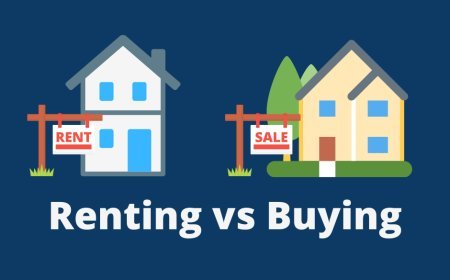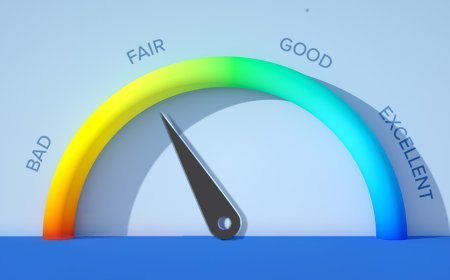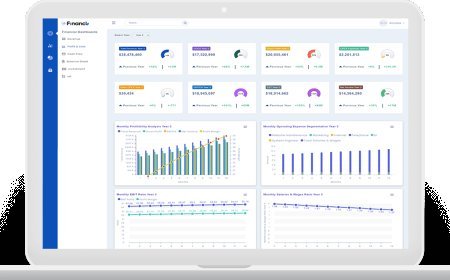Investing for Beginners: The Only Guide You’ll Ever Need in 2025
In this complete guide, we explore how to confidently navigate the investment landscape of 2025. Discover essential financial concepts, learn smart strategies like diversification and dollar-cost averaging, and uncover the best practices to build lasting wealth, even if you're starting small.

I. Introduction: Why 2025 is Your Year to Start Investing
The journey into investing can seem daunting, but it represents one of the most impactful steps an individual can take toward securing long-term financial stability and achieving significant life aspirations. In essence, investing is the deliberate act of allocating capital into various assets, such as shares of companies, government or corporate debt, or physical property, with the fundamental expectation that these assets will appreciate in value over time. This approach fundamentally diverges from traditional saving, which typically involves depositing money into low-interest accounts where the primary focus is on liquidity and minimal risk. While saving provides a safety net, investing involves a calculated degree of risk, balanced by the potential for substantially greater financial returns.
The Power of Investing: Beating Inflation and Building Wealth
A primary driver for engaging in investment activities is the imperative to counteract the insidious effect of inflation. Inflation, characterized by the gradual increase in the price of goods and services across an economy, acts as a "silent wealth erosor," steadily diminishing the purchasing power of money over time. If money is merely held in a standard savings account, its real value will decline as prices rise, meaning it will buy less in the future than it does today. Investing provides a critical defense against this erosion, enabling capital to grow at a rate that outpaces inflation. For instance, historical data indicates that a broad market index like the S&P 500 has delivered an inflation-adjusted annual average return of approximately 7%, a figure that significantly surpasses the typical yields offered by basic savings accounts. This growth not only preserves the value of capital but actively enhances its real purchasing power.
Beyond merely preserving wealth, investing serves as a powerful engine for its creation. The stock market, in particular, has a well-documented history of generating higher returns over the long term compared to more conservative savings vehicles such as savings accounts or certificates of deposit. This inherent growth potential is indispensable for realizing ambitious financial objectives, whether it involves accumulating sufficient funds for a comfortable retirement, amassing a down payment for a home, or financing a child's higher education. Investing transforms stagnant capital into a dynamic force, actively working to expand an individual's financial capacity.
Why Start Now? The Advantage of Time and Compounding
In the realm of financial growth, time is arguably the most invaluable asset an investor possesses. The earlier an individual embarks on their investment journey, the more profoundly they can harness the transformative power of compound growth, often referred to as the "magic" of wealth accumulation. Compounding is a process where the initial investment generates returns, and then those returns themselves begin to earn additional returns, creating an accelerating, snowball effect over time. This exponential growth mechanism means that even modest, consistent contributions, when initiated early and maintained regularly, possess the capacity to accumulate into substantial wealth over a sufficient period.
The emphasis on starting now, particularly in a guide framed for "2025," carries a profound implication. While the specific economic conditions and regulatory landscape of 2025 are certainly relevant for what to invest in and how to approach it, the fundamental principle of leveraging time in investing transcends any particular annual market cycle. The advice that "the best time to invest was yesterday; the second-best time is today" directly translates to every single day within 2025. This understanding creates a powerful sense of urgency and empowerment for the novice investor. It clarifies that the optimal moment to begin is not some elusive future point, nor is it solely dependent on perfect market conditions. Instead, it underscores the perpetual advantage of immediate action. For a beginner, this reinforces that the "best" time to commence their investment journey is always now, regardless of specific market forecasts or perceived optimal entry points, making the core message of this guide timeless in its applicability.
II. Essential Financial Concepts for New Investors
Embarking on an investment journey requires a foundational understanding of key financial concepts that govern how money grows and how its value is affected over time. These principles are not merely academic; they are practical tools for informed decision-making.
Understanding Compounding: The "Magic" of Growth
Compounding is frequently lauded as one of the most powerful forces in finance. Its mechanism involves the continuous reinvestment of earnings—whether interest or capital gains—back into the original principal investment. Consequently, in each subsequent period, the returns are calculated not only on the initial principal but also on all previously accumulated earnings. This iterative process leads to an accelerating growth rate for the investment's total value. The magnitude of this compounding effect is significantly influenced by three primary factors: the interest rate or rate of return achieved, the length of the time horizon over which the investment compounds, and the frequency with which the earnings are reinvested. Even small, consistent investments, when initiated early and allowed sufficient time, can leverage compounding to generate substantial wealth, illustrating its profound impact on long-term financial accumulation.
Inflation: The Silent Wealth Eroder
Inflation, defined as the general and sustained increase in the price level of goods and services within an economy, directly diminishes the purchasing power of money over time. This concept holds particular significance for long-term financial planning, especially when considering objectives such as retirement. Elevated inflation can create a widening gap between an individual's income and their expenses, as their money loses value and can purchase fewer goods and services, while the costs of essential items like food, fuel, healthcare, and education continue to climb. To ensure that investments genuinely contribute to an individual's wealth and maintain their desired lifestyle, it is imperative that they consistently achieve returns that surpass the prevailing rate of inflation.
The interplay between compounding, inflation, and the investment time horizon is a critical aspect for any new investor to grasp. While compounding acts as the engine driving wealth growth, inflation functions as a persistent drag on that growth. The longer the investment horizon, the more pronounced both the beneficial effects of compounding and the corrosive effects of inflation become. This means that simply earning a nominal return on an investment is insufficient; the real return—that is, the return after accounting for inflation—is what truly determines the increase in an individual's purchasing power and, consequently, their actual wealth. This understanding provides a compelling rationale for taking on a calculated level of investment risk. It clarifies that the pursuit of returns exceeding inflation is not merely an optional goal but an essential strategy to ensure that compounding genuinely leads to real wealth accumulation, rather than simply maintaining pace with rising costs.
Risk vs. Return: Finding Your Balance
Every investment inherently involves a degree of risk, which is the possibility of experiencing a loss of some or all of the invested capital. This risk is typically correlated with the potential for returns: generally, investments that offer the prospect of higher returns also carry a higher level of risk, whereas lower-risk investments tend to provide more stable but comparatively modest returns. A fundamental and indispensable step in formulating an investment strategy is to accurately assess and define one's personal comfort level with this inherent risk-reward trade-off. This assessment forms the bedrock upon which the entire investment portfolio is constructed.
Quick Mental Math: Rules of 72, 114, 144, and 70
To assist beginners in quickly grasping the practical implications of compounding and inflation without resorting to complex mathematical calculations, several "rules of thumb" serve as highly useful mental shortcuts. While these rules provide approximations rather than exact figures, they offer valuable insights for financial planning:
-
Rule of 72: This rule estimates the number of years it will take for an investment to double in value. To apply it, simply divide 72 by the annual interest rate or rate of return. For example, if an investment yields a 15% annual return, it would approximately double in 4.8 years (72 / 15).
-
Rule of 114: To estimate the time required for an investment to triple in value, divide 114 by the annual interest rate. At a 10% interest rate, an investment would roughly triple in 11.4 years (114 / 10).
-
Rule of 144: This rule provides an approximation for how long it will take for an investment to quadruple. The calculation involves dividing 144 by the annual interest rate. For instance, at a 10% interest rate, an investment would grow fourfold in approximately 14.4 years (144 / 10).
-
Rule of 70: This rule is particularly useful for understanding the impact of inflation on purchasing power. It helps estimate how long it will take for the value of money to be cut in half due to inflation. To calculate this, divide 70 by the current annual inflation rate. For example, at a 4% inflation rate, the purchasing power of money would halve in about 17.5 years (70 / 4).
These mental math shortcuts offer more than just quick calculations; they serve as practical tools for behavioral finance. For novice investors, who might find complex financial models intimidating, these simple rules demystify the concepts of growth and inflation. By making these powerful financial principles more tangible and accessible, they foster a greater sense of control and understanding, which can, in turn, reduce anxiety and encourage consistent action. This accessibility helps new investors internalize the long-term implications of their financial decisions, reinforcing the importance of starting early and staying invested.
Table 1: Quick Financial Rules of Thumb
| Rule Name | What It Calculates | How to Calculate | Example (at 10% interest/inflation) | Source |
| Rule of 72 | Years for money to double | 72 / Interest Rate | ~7.2 years | |
| Rule of 114 | Years for money to triple | 114 / Interest Rate | ~11.4 years | |
| Rule of 144 | Years for money to quadruple | 144 / Interest Rate | ~14.4 years | |
| Rule of 70 | Years for money's purchasing power to halve (due to inflation) | 70 / Inflation Rate | ~7.0 years (at 10% inflation) |
This table provides a clear, actionable framework for beginners to quickly estimate the impact of compounding and inflation on their finances. It distills complex mathematical ideas into simple, memorable rules, empowering individuals with immediate, practical tools. By presenting these rules, the table subtly yet effectively reinforces the profound power of compounding over time and the critical importance of accounting for inflation in long-term financial goals, making these abstract concepts much more concrete and relatable for a novice investor.
III. Getting Your Financial House in Order Before Investing
Before committing any capital to investment vehicles, establishing a robust personal financial foundation is not merely advisable but a non-negotiable prerequisite. This foundational work ensures that investment efforts are built on stable ground, maximizing their potential for success and minimizing the risk of forced, detrimental liquidations.
Building Your Emergency Fund
The establishment of a robust emergency fund stands as the first and most critical step before any investment capital is deployed. This fund should ideally comprise three to six months' worth of essential living expenses. It is imperative that this capital is held in an easily accessible and highly liquid account, such as a high-yield savings account, guaranteeing immediate availability should unforeseen financial demands arise. The fundamental purpose of this fund is to serve as a crucial financial safety net, preventing individuals from being compelled to liquidate long-term investments prematurely—and potentially at a loss—during unexpected financial crises, such as job loss, medical emergencies, or significant home repairs. Without this buffer, a temporary market downturn coinciding with a personal emergency could transform a paper loss into a permanent, realized capital loss, severely undermining long-term financial goals.
Tackling High-Interest Debt
Another pivotal step preceding investment is the aggressive repayment of any outstanding high-interest debt. This category typically includes credit card balances, personal loans, or other forms of debt where the annual percentage rates (APRs) significantly exceed the potential returns one might realistically expect from market investments. The "return" generated by eliminating high-interest debt, through the avoidance of future interest payments, is a guaranteed and often substantial benefit that frequently surpasses the uncertain, albeit potentially higher, returns from market-based investments. Prioritizing the eradication of such debt is a financially astute immediate action that not only improves an individual's overall financial health but also liberates future capital that can then be deployed more effectively into wealth-building investments.
Assessing Your "Extra" Money for Investing
Once a solid emergency fund is in place and high-interest debt has been managed, the next logical step involves creating a detailed budget. This budgeting process is essential for clearly identifying the amount of discretionary income available each month after all necessary expenses have been covered. It is paramount to invest only that money which an individual can genuinely afford to set aside for an extended period, without needing to access it for immediate living expenses. This principle is critical because investing is, by its very nature, a long-term strategy characterized by fluctuating asset values and an absence of guarantees regarding short-term liquidity. Even if the initial amount available for investment appears modest, the most crucial aspect is to establish a pattern of consistent contributions, allowing the twin forces of time and compounding to work their transformative effects.
The sequential nature of these steps—emergency fund first, then high-interest debt, then investing—is not arbitrary; it is a strategic imperative designed to protect the integrity and long-term viability of the investment strategy itself. The absence of an emergency fund, for instance, means that a sudden financial shock could compel an investor to liquidate assets during a market downturn, thereby converting a temporary paper loss into a permanent, realized capital loss. This forced sale negates the benefits of long-term growth and dollar-cost averaging. Similarly, the guaranteed drain of high-interest debt fundamentally undermines the very purpose of seeking investment growth, as the interest paid on debt can easily outstrip any investment returns. Therefore, these foundational steps are essential safeguards. They ensure that the capital committed to investing can truly remain invested for the long term, allowing it to weather market volatility and fully benefit from compounding, thus significantly increasing the probability of achieving desired financial goals.
IV. Setting Your Investment Goals and Time Horizon
Before any capital is allocated to specific investment vehicles, a clear articulation of why one is investing is paramount. Investment goals provide the essential purpose and direction to all financial endeavors.
Defining Your "Why": Retirement, Home, Education, etc.
The initial and most critical step in an investment journey is to precisely define the underlying motivation for investing. These investment goals serve as the guiding principles and ultimate destinations for one's financial efforts. Common aspirations that drive individuals to invest include securing a comfortable retirement, accumulating a sufficient down payment for a home, financing a child's higher education, or simply achieving a broader state of financial independence. A clear and unambiguous understanding of these objectives will fundamentally inform and direct all subsequent investment choices and strategies, ensuring that capital is deployed in the most effective manner possible to meet these specific aims.
The SMART Approach to Goal Setting
To transform abstract financial aspirations into actionable and achievable targets, it is highly beneficial to apply the SMART framework. This mnemonic provides a structured approach to goal setting:
-
Specific: Goals should be detailed and unambiguous. For example, instead of a vague "Save for a house," a specific goal would be "Save $50,000 for a home down payment."
-
Measurable: Establish clear, quantifiable metrics that allow for tracking progress and determining whether one is on target or falling short of the objective.
-
Achievable: Set goals that are realistic and within one's capacity to reach, considering current financial situation and available resources.
-
Realistic: Goals should be grounded in practical reality, not far-fetched dreams, ensuring they are attainable within the broader financial context.
-
Time-based: Assign a specific deadline or a clear timeline for when each goal is intended to be achieved. This element injects a sense of urgency and facilitates appropriate planning and strategy adjustments.
Short-Term, Medium-Term, and Long-Term Goals
Segmenting financial goals based on their anticipated time horizon is crucial for aligning them with suitable investment strategies and appropriate risk levels.
-
Short-term goals: These are objectives projected to be achieved within a timeframe of one year or less. Examples include establishing or replenishing an emergency fund, saving for a specific, smaller purchase (such as a new television or upgraded appliance), or paying off a small, manageable debt. For these goals, paramount importance is placed on liquidity, meaning the funds should be held in easily accessible accounts like savings accounts or money market funds.
-
Medium-term goals: These typically encompass objectives spanning one to five years. Common examples include the repayment of larger debts (like student loans), accumulating a significant down payment for a home, or planning a substantial home renovation project. Investments for these goals might involve a slightly higher degree of risk compared to short-term savings, but they still necessitate a relative emphasis on stability and capital preservation.
-
Long-term goals: These are objectives situated five years or more into the future, frequently extending several decades out. Retirement planning, funding a child's college education, or acquiring a second home fall squarely into this category. The extended time horizon associated with these goals provides a substantial buffer, allowing for a greater tolerance of risk. This enables the allocation of capital to less liquid, higher-growth investments such as stocks, diversified mutual funds, Exchange-Traded Funds (ETFs), or even direct real estate or Real Estate Investment Trusts (REITs). Such accounts often come with significant tax advantages, further enhancing their suitability for long-term wealth accumulation.
Aligning Goals with Investment Choices
An individual's investment strategy should serve as a direct reflection of their defined financial goals, their age-related timeline, and their personal risk tolerance. For long-term objectives, the extended time frame provides a crucial buffer, allowing investments ample opportunity to recover from any potential market downturns and to fully capitalize on the power of compounding. This extended horizon inherently permits a higher degree of risk to be assumed in pursuit of greater returns. Certain investment products, such as target-date funds, are specifically engineered to align with a future goal year. These funds automatically adjust their underlying asset allocation, gradually shifting from more aggressive, growth-oriented investments to more conservative, capital-preservation-focused assets as the target date approaches.
The connection between defining investment goals and the subsequent choices in risk and asset allocation is fundamental. Goals are not merely aspirations; they function as the primary drivers of the entire investment strategy, dictating the acceptable level of risk and the specific types of assets that should be chosen. Without clearly articulated goals, risk tolerance becomes an abstract concept, and asset allocation lacks a coherent purpose, potentially leading to "aimless" investing. This understanding establishes a critical causal chain: Goals → Time Horizon → Risk Capacity/Tolerance → Appropriate Asset Allocation. For beginners, this means that defining "what you're saving for" is not just a preliminary step but the foundational and most critical decision in their investment journey. It provides the logical rationale for every subsequent choice, from selecting account types to specific investments. This clarity helps prevent arbitrary investment decisions and significantly increases the likelihood of adhering to a long-term plan, even amidst market volatility, because the underlying "why" is firmly established and understood.
Table 2: Investment Goals by Time Horizon
| Goal Category | Typical Time Horizon | Examples of Goals | Recommended Investment Approach/Vehicles | Key Considerations |
| Short-Term | < 1 year | Emergency Fund, New TV, Small Debt Payoff | Liquid Savings Accounts, Money Market Funds, CDs | Liquidity is paramount; capital preservation |
| Medium-Term | 1-5 years | Student Loan Payoff, Home Down Payment, Home Renovation | Balanced Portfolio, Less Volatile Funds, Short-term Bonds | Moderate risk; balance stability and growth |
| Long-Term | 5+ years | Retirement, Child's College Education, Second Home | Growth-Oriented Investments, Stocks, Mutual Funds, ETFs, Real Estate/REITs, Tax-Advantaged Accounts | Higher risk tolerance; focus on long-term growth; tax advantages |
This table serves as a structured decision-making tool for beginners. The vast array of investment options can be overwhelming, and this table provides a clear, actionable framework to categorize financial aspirations, directly linking each type of goal to appropriate investment strategies and vehicles. It also offers intuitive risk management by explicitly showing why highly volatile assets are unsuitable for immediate needs, thereby helping to prevent common and costly mistakes. By distilling a complex decision-making process into an easy-to-understand visual guide, this table makes the initial steps of investing less daunting and more navigable, empowering individuals to make informed choices.
V. Understanding Your Personal Risk Tolerance
A comprehensive understanding of one's personal risk tolerance is an indispensable component for constructing and maintaining a sustainable investment portfolio. This tolerance is not a monolithic concept but rather a composite of two distinct yet interconnected factors.
Risk Capacity vs. Willingness to Take Risk
Understanding one's risk tolerance involves differentiating between two key components:
-
Risk Capacity: This represents an objective assessment of the maximum financial loss an individual can withstand without jeopardizing their ability to achieve their critical financial goals. It is determined by quantifiable and tangible factors such as an individual's age, their investment time horizon (how long until the money is needed), their current savings rate, the stability of their income, and their overall net worth. For instance, a longer investment horizon generally implies a greater capacity to absorb risk, as there is more time for investments to recover from potential market downturns before the funds are required.
-
Willingness to Take Risk: This is the more subjective and psychological dimension, reflecting an individual's emotional comfort level with potential losses and the inherent fluctuations of financial markets. It is deeply rooted in one's personality and how they anticipate reacting to periods of market volatility. An investor who possesses a genuine aversion to significant risk will likely experience considerable discomfort and anxiety with an aggressive, high-volatility portfolio, potentially leading to impulsive and detrimental decisions during market swings.
Factors Influencing Your Risk Tolerance: Age, Time Horizon, Financial Stability
Several factors significantly influence an individual's risk tolerance:
-
Age/Time Horizon: These are among the most critical determinants of risk tolerance. Younger investors, who typically have longer time horizons (e.g., 10 or more years until a major financial goal like retirement), generally possess a higher capacity and often a greater willingness to invest aggressively. A widely cited rule of thumb suggests subtracting one's age from 100 to estimate the percentage of a portfolio that might appropriately be allocated to stocks (e.g., a 30-year-old might consider having approximately 70% of their portfolio in stocks). Conversely, as an individual approaches a specific financial goal or retirement, it is a prudent strategy to gradually reduce the portfolio's overall risk exposure to safeguard accumulated capital.
-
Financial Stability: An individual's current financial health profoundly impacts their risk capacity. Factors such as a stable and reliable income, a healthy ratio of savings relative to living expenses, and a positive net worth provide a more substantial buffer against potential investment losses. Furthermore, the importance or criticality of a particular financial goal can also influence one's willingness to assume risk. For instance, an individual might be more inclined to take on higher risk for a discretionary goal like purchasing a vacation home than for a non-negotiable objective such as funding a child's education.
Self-Assessment: What Potential Gains and Losses Are You Comfortable With?
To genuinely ascertain one's risk tolerance, engaging in self-assessment is highly beneficial. This involves considering hypothetical scenarios that illustrate potential gains and losses across various risk levels, thereby allowing an individual to gauge their emotional comfort and anticipated reactions to real-world market volatility. This exercise helps in preparing for how one might respond when faced with actual market fluctuations. For a more structured and objective assessment, individuals can utilize online risk tolerance questionnaires. Ideally, consulting with a qualified financial professional can provide an invaluable objective perspective, assisting in accurately determining and aligning one's risk profile with their financial objectives.
It is important to recognize that risk tolerance is not a static concept but a dynamic one. While initial assessments are crucial, it is explicitly stated that risk tolerance should be "revisited often" and that it will "change over the course of time". This understanding underscores that an individual's risk profile is not a fixed attribute but evolves in response to changing life stages, shifts in financial standing, and personal experiences. For example, a career change, marriage, the birth of children, or approaching retirement can all fundamentally alter both an individual's financial capacity to absorb losses and their psychological willingness to endure market volatility. This dynamic nature means that an initial risk assessment is merely a starting point, not a permanent fixture. This understanding highlights the critical importance of periodic review (at least annually, as suggested for goals) and flexibility within one's investment plan. A proactive approach to managing this evolving risk tolerance helps prevent common and costly mistakes, such as panic selling during market downturns, because the portfolio can be adjusted to align with current comfort levels and life circumstances, rather than being based on an outdated or rigid assessment. This continuous alignment fosters long-term adherence to the investment plan and builds sustained confidence.
VI. Your Investment Toolkit: Types of Accounts and Vehicles
Once an individual's financial foundation is secure and their goals and risk tolerance are clearly defined, the next step involves selecting the appropriate "containers" for their investments and the specific assets to hold within them.
Choosing the Right Account
The choice of investment account is as significant as the investments themselves, primarily due to varying tax implications and withdrawal rules.
-
Tax-Advantaged Accounts: These accounts are specifically designed to incentivize long-term savings, particularly for retirement, by offering significant tax benefits.
-
401(k)s: Typically employer-sponsored, these plans allow individuals to contribute a portion of their paycheck, often before taxes are deducted. A substantial advantage of 401(k)s is the potential for employer matching contributions, where the company contributes a percentage of the employee's contributions—effectively "free money" that can significantly accelerate savings growth. Contributions are frequently automated, which promotes consistent investing habits.
-
IRAs (Individual Retirement Accounts): These accounts generally offer greater flexibility in investment options compared to many employer-sponsored plans, which might have a more limited selection of funds.
-
Traditional IRA: Contributions may be tax-deductible in the year they are made, and investments grow tax-deferred, meaning taxes are only paid upon withdrawal in retirement.
-
Roth IRA: Contributions are made with after-tax money, which means there is no upfront tax deduction. However, qualified withdrawals in retirement are entirely tax-free. It is important to note that Roth IRAs may have income restrictions that limit eligibility for contributions.
-
-
-
Flexible Accounts: Brokerage Accounts
-
Brokerage accounts are general investing accounts that provide substantial flexibility. Unlike retirement accounts, they are not subject to early withdrawal penalties, making them suitable for saving for short-to-medium term goals such as a down payment on a home or a wedding. These accounts offer access to a wide array of investment types and typically have no contribution limits or income restrictions. However, they generally do not provide upfront tax deductions for contributions, and any earnings are taxed as capital gains or ordinary income in the year they are realized.
-
-
Other Options:
-
HSAs (Health Savings Accounts): For individuals enrolled in high-deductible health plans, HSAs offer a unique "triple tax advantage": contributions are tax-deductible, investments grow tax-free, and qualified withdrawals for medical expenses are also tax-free. Many HSAs also include investment options, allowing the funds to grow over time.
-
SEP-IRAs/SIMPLE IRAs: These are retirement plans specifically designed for small business owners and self-employed individuals, offering tax advantages similar to traditional IRAs or 401(k)s, tailored to the unique needs of business owners.
-
Micro-Investing Apps: For those starting with very modest amounts, these applications make investing highly accessible. They allow individuals to invest spare change or small, regular contributions into diversified portfolios, often with minimal capital requirements. Some micro-investing apps even feature automatic round-ups, where purchases are rounded up to the nearest dollar, and the difference is automatically invested.
-
Understanding Investment Types
Once an account "container" has been selected, the next step involves choosing the specific investments that will reside within it.
-
Stocks: Owning a Piece of a Company
-
Stocks represent shares of ownership, or "equity," in a publicly traded company. Companies issue stocks primarily to raise capital for their growth and operational needs. As a shareholder, an investor can potentially benefit from the company's success through an increase in the stock price (known as capital appreciation) and, in some instances, through regular payments called dividends, which represent a portion of the company's earnings distributed to shareholders. Stocks offer the potential for high returns and significant long-term growth; however, they inherently carry higher risk due to their price volatility, meaning their value can fluctuate considerably.
-
-
Bonds: Lending to Governments or Companies
-
A bond is fundamentally a loan made by an investor to a company, government, or municipality. In exchange for this loan, the issuer promises to pay the investor a specified rate of interest (the "coupon amount") over a predetermined period and to repay the original principal amount (the "face value") when the bond "matures". Bonds are generally perceived as less risky than stocks, offering a more stable and predictable income stream. Common types include corporate bonds (issued by companies), municipal bonds (issued by states and cities, often with tax advantages), and U.S. Treasuries (issued by the U.S. government, considered among the safest investments). While safer, bond prices can still fluctuate, particularly in response to changes in prevailing interest rates.
-
-
Mutual Funds: Professionally Managed Diversification
-
A mutual fund operates by pooling money from numerous investors to collectively purchase a diversified portfolio of securities, which can include stocks, bonds, or other assets. These portfolios are actively managed by professional fund managers who conduct extensive research and make investment decisions on behalf of the fund's shareholders. Mutual funds provide instant diversification across a wide range of companies and industries, a feature that significantly reduces the risk associated with investing in individual securities. Their shares are priced once daily, typically after the close of the market, based on their Net Asset Value (NAV). Many mutual funds feature low or even zero minimum initial investment requirements, making them accessible to a broad spectrum of investors.
-
-
Exchange-Traded Funds (ETFs): Like Mutual Funds, Traded Like Stocks
-
ETFs share similarities with mutual funds in that they invest in a diversified "basket of securities". However, a key distinguishing characteristic is that ETFs are traded on stock exchanges throughout the trading day, much like individual stocks, which allows for real-time pricing and greater trading flexibility. Many ETFs are designed to track specific market indexes (such as the S&P 500), thereby providing broad diversification and typically featuring lower expense ratios (fees) compared to many actively managed mutual funds.
-
-
Real Estate: Direct Ownership vs. REITs
-
Investing in real estate offers distinct opportunities for both income generation and capital appreciation.
-
Direct Ownership: This approach involves the direct purchase of physical properties, such as residential homes (single-family or multi-family units) or commercial properties (office buildings, retail spaces), typically with the aim of generating rental income or benefiting from long-term value growth. Direct ownership provides greater control over the asset and can offer various tax advantages, including deductions for mortgage interest, property taxes, and depreciation, as well as leverage opportunities through mortgages. However, it typically requires a significant upfront capital investment, involves ongoing management responsibilities (or the cost of hiring a property management company), and is generally less liquid than other investment types.
-
REITs (Real Estate Investment Trusts): REITs are companies that own, operate, or finance income-producing real estate across diverse sectors (e.g., office buildings, shopping malls, apartments). They are often conceptualized as the "mutual funds of the real estate world" because they enable individuals to invest in large-scale real estate without the direct, hands-on demands of property ownership. Publicly traded REITs offer high liquidity, as their shares can be bought and sold quickly on stock exchanges. By law, REITs are mandated to distribute at least 90% of their taxable income to shareholders as dividends, making them an appealing option for income-focused investors.
-
-
The inherent structure of mutual funds and ETFs provides a significant advantage for new investors, particularly those with limited capital. While diversification is a broadly recognized principle for risk management, these fund structures offer multiple layers of diversification. They diversify across various assets, sectors, and geographies within a single investment vehicle. This layered diversification is a powerful benefit for beginners, as it allows them to achieve broad market exposure instantly, a feat that would be impractical or even impossible if they were to attempt to build such a diversified portfolio solely through individual stock or bond purchases. These funds democratize access to sophisticated portfolio construction and professional management, making it feasible for small-dollar investors to gain wide market exposure from the outset. This is especially relevant given the encouragement to start investing small amounts frequently, as these funds ensure that even modest contributions are immediately diversified, reducing concentrated risk.
Furthermore, the emphasis on tax-advantaged accounts like 401(k)s and IRAs alongside the discussion of 2025 regulatory changes regarding alternative assets in 401(k)s points to a broader, underlying theme: governmental and regulatory bodies actively create incentives and pathways to encourage individual investing, particularly for long-term goals like retirement. This is not merely about providing individual choice but reflects a systemic effort to promote financial stability across the population. The 2025 Executive Order to "democratize access to alternative assets for 401(k) investors" and "expand investment choices for 401(k) plans" to offer "better returns and diversification" is a clear policy-driven initiative. This suggests that the investment landscape for beginner investors in 2025 is becoming more supportive and intentionally structured from a regulatory perspective, beyond just market dynamics. The government is actively working to remove historical barriers, such as "regulatory overreach and litigation risks", and enhance opportunities within common retirement vehicles. For a beginner, this implies that leveraging these tax-advantaged accounts should be a top priority, as they are not only designed with long-term financial benefit in mind but are also continually being refined by policymakers to offer broader and potentially more rewarding investment avenues.
VII. Smart Investment Strategies for Beginners
Beyond selecting the right accounts and understanding investment types, employing smart strategies is crucial for long-term success, especially for new investors.
Diversification: Don't Put All Your Eggs in One Basket
Diversification is arguably the most fundamental and crucial strategy for any investor, particularly for beginners. It involves strategically spreading investments across various asset classes, geographies, and sectors with the primary objective of mitigating risk. The core principle underpinning diversification is that if one segment of a portfolio experiences poor performance, other segments may perform well, thereby cushioning the overall impact on the individual's wealth.
-
Asset Diversification: This entails investing in a mix of different asset classes, such as stocks (chosen for their growth potential), bonds (valued for stability and income), cash (for liquidity and immediate needs), and real estate (for long-term value appreciation). Each asset class typically responds differently to various economic conditions, which helps balance the overall portfolio performance during different market cycles.
-
Geographic Diversification: Investing beyond one's home country or region helps to reduce concentrated risk by exposing the portfolio to diverse economic and political conditions across the globe. For example, during a downturn in one national market, investments in other global markets might be thriving, providing a counterbalance.
-
Sector Diversification: Within the broader stock market, it is vital to spread investments across various industries, such as technology, healthcare, energy, and financials. Different sectors tend to perform optimally at different times, so diversification helps avoid over-reliance on the fortunes or misfortunes of any single industry.
-
Diverse Investment Types: Beyond broad asset classes, diversification also extends to utilizing different investment vehicles. This includes a mix of individual stocks, bonds, mutual funds, Exchange-Traded Funds (ETFs), and Real Estate Investment Trusts (REITs), each offering unique risk-return profiles and contributing to the portfolio's overall resilience.
Dollar-Cost Averaging: Investing Consistently
Dollar-cost averaging (DCA) is a disciplined and highly effective strategy particularly well-suited for beginners. It involves investing a fixed amount of money at regular intervals (e.g., weekly, monthly, or bi-weekly), irrespective of the current market price of the investment.
-
Benefits:
-
Risk Management: DCA helps mitigate the significant risk associated with investing a large lump sum at an unfavorable market peak. By spreading out purchases over time, an investor automatically buys more shares when prices are lower and fewer shares when prices are higher, which can potentially lead to a lower average cost per share over the long term.
-
Removes Market Timing Stress: This strategy effectively eliminates the difficult and often futile attempt to "time the market"—that is, predicting its highs and lows—a challenge that even seasoned professional investors struggle with.
-
Fosters Discipline: DCA inherently promotes consistent investing habits, making regular contributions a routine part of an individual's financial life. This disciplined approach helps in avoiding emotional, impulsive decisions that often arise during periods of market volatility.
-
-
How to Implement (Manual vs. Automatic): DCA can be implemented manually by setting a recurring reminder to make investments. However, the easiest and most consistent approach is to automate the process. Most brokerage accounts offer the option to set up automatic recurring investments. Furthermore, if an individual contributes to an employer-sponsored 401(k) or similar retirement plan, they are already practicing DCA, as contributions are automatically deducted from each paycheck.
The deeper value of dollar-cost averaging extends beyond its mathematical benefits; it functions as a powerful behavioral finance tool. While it is clearly presented as a risk management strategy and a cost-effective method, its profound utility lies in its ability to counteract inherent human psychological biases. It explicitly helps to "mitigate the effects of investor psychology" and to "avoid making a counter-productive decision due to emotions like fear or greed". This means that DCA is not just a financial technique but a fundamental behavioral safeguard against impulsive and potentially detrimental actions. For beginners, who are often more susceptible to emotional reactions to market volatility—such as panic selling during downturns or buying exuberantly at peaks—DCA provides a structured discipline that bypasses these human tendencies. By automating the investment process and committing to a fixed schedule, it acts as a built-in mechanism that fosters consistency and emotional detachment, thereby significantly increasing the likelihood of long-term investment success.
The Long-Term Growth Mindset
Investing is fundamentally a long-term endeavor, and the most successful strategies are invariably built upon a foundation of patience and consistency.
-
Why Patience Pays Off: A longer holding period provides investments with ample time to navigate the inevitable ups and downs of the market, recover from temporary losses, and fully capitalize on the exponential power of compounding. Attempting to achieve quick gains often leads to impulsive, ill-informed decisions and ultimately, financial losses.
-
Avoiding Market Timing: One of the most common and costly mistakes made by beginners is the futile attempt to "time the market"—that is, trying to buy investments precisely when prices are at their lowest and sell them when they are at their highest. This endeavor is exceedingly difficult, even for highly experienced professional investors. Research consistently demonstrates that missing even a few of the stock market's best-performing days, which frequently occur unexpectedly after significant declines, can drastically reduce an individual's long-term returns. A disciplined, long-term approach helps investors to remain invested through market fluctuations and to effectively filter out the short-term "noise" that can provoke emotional reactions.
VIII. Navigating the 2025 Investment Landscape
As individuals embark on their investment journey in 2025, understanding the broader economic landscape and pertinent regulatory developments is crucial for setting realistic expectations and adapting investment strategies effectively.
Economic Outlook for 2025
The global economic outlook for 2025 suggests a period of stable but somewhat modest growth, often characterized as "tenuous resilience" rather than explosive expansion. Global growth projections generally range from 3.0% to 3.3%. While advanced economies might experience a slight acceleration in growth, emerging markets could see a modest slowdown.
Regarding inflation, global headline figures are forecast to continue their decline, reaching approximately 4.4-4.5% in 2025. However, core inflation, which excludes volatile food and energy prices, is anticipated to decline more gradually. Notably, inflation in the U.S. is predicted to remain above target, and factors such as elevated fiscal spending and potential tariff hikes could contribute to inflation proving more "tenacious" than desired.
Central bank policy rates, which have been elevated to combat inflation, are expected to continue weighing on economic activity. While inflation is falling faster than anticipated in most regions due to unwinding supply-side issues and restrictive monetary policy, the return to target inflation rates is unlikely before 2025 in many cases. This suggests that interest rates may remain "higher for longer," influencing the attractiveness of different asset classes, with corporate bonds, for instance, potentially remaining appealing due to still-high yields and institutional demand. Geopolitical tensions and increased policy uncertainty are identified as persistent downside risks, contributing to overall market volatility. Investors should be prepared for potential trade and geopolitical risks, emphasizing the need for a broad-based portfolio and active risk management.
Investment Regulatory Changes for Individual Investors in 2025
The regulatory environment in 2025 also presents notable developments that could impact individual investors, particularly concerning retirement accounts.
A significant development is the Executive Order signed by President Donald J. Trump on August 7, 2025, aimed at "democratizing access to alternative assets for 401(k) investors". This order instructs the Secretary of Labor to clarify the Department of Labor's stance on alternative assets and the appropriate fiduciary process for offering asset allocation funds that include these investments. Furthermore, it directs the Securities and Exchange Commission (SEC) to facilitate access to alternative assets for participant-directed defined-contribution retirement savings plans by revising applicable regulations and guidance. The stated goal is to enhance workers' retirement growth by expanding investment choices, addressing previous limitations imposed by "regulatory overreach and litigation risks" that hindered ERISA-governed plan fiduciaries from including alternative assets in their portfolios. This change could potentially open up new avenues for diversification and returns within traditional retirement accounts.
Beyond this executive action, the SEC has also made other regulatory updates with compliance dates in 2025. For example, the SEC postponed compliance requirements for Rule 13f-2 under the Securities Exchange Act and reporting requirements on Form SHO, with the new compliance date for Form N-PORT and N-CEN amendments for larger fund complexes set for November 17, 2025. Additionally, amendments to Regulation S-P, requiring financial entities to adopt incident response programs for unauthorized access to customer information, have a compliance date of December 3, 2025. The Names Rule Amendments, which affect how funds can use certain terms in their names (e.g., "tax-sensitive" or "income"), also have a compliance date of December 11, 2025. While some of these changes are more technical and primarily affect institutional managers and fund reporting, the broader regulatory trend indicates an ongoing effort to refine market transparency, investor protection, and investment accessibility.
IX. Common Investment Mistakes Beginners Make & How to Avoid Them
Even with the best intentions, new investors often fall prey to common pitfalls. Awareness of these mistakes is the first step toward avoiding them and building a more resilient investment journey.
-
Lacking a Clear Financial Plan: One of the most fundamental errors is investing without a defined roadmap. Without clear goals, time horizons, and a tailored strategy, investment decisions can become arbitrary and lack purpose. A well-articulated plan serves as a compass, guiding decisions and allowing for periodic assessment of progress.
-
Misunderstanding True Risk Tolerance: Many beginners overestimate their comfort with risk, only to panic and sell during market downturns. It is crucial to objectively assess both one's capacity to bear risk (based on financial situation) and one's emotional willingness to tolerate market fluctuations. Regular reassessment of risk tolerance is vital as circumstances change.
-
Failing to Diversify and Rebalance: Putting all capital into a single investment type, sector, or company concentrates risk and can lead to disastrous outcomes if that specific area underperforms. Diversification spreads risk across various assets, geographies, and sectors, cushioning the portfolio against downturns in any one area. Regular rebalancing ensures the portfolio remains aligned with target allocations and risk profile as market values shift.
-
Trying to Time the Market: The attempt to predict market highs and lows—buying low and selling high—is notoriously difficult and often leads to missed opportunities and reduced long-term returns. Research indicates that some of the largest stock market gains occur unexpectedly after significant declines, meaning that being out of the market during these crucial days can severely impact overall returns. A disciplined, consistent approach, such as dollar-cost averaging, is generally more effective.
-
Chasing Performance: Investing in assets or funds solely because they have performed exceptionally well in the recent past, often referred to as "chasing hot tips," can be a costly mistake. By the time such information becomes public, it has often already been factored into market pricing. Focus should remain on long-term trends and macroeconomic factors that align with one's established plan, rather than short-term fads.
-
Ignoring Fees and Expenses: High fees and account costs can significantly erode investment returns over time. It is essential to be aware of all associated costs, including account management fees, trading commissions, and expense ratios of funds. Seeking advice from a financial professional can help navigate these expenses effectively.
-
Making Emotional Decisions: Reacting impulsively to market fluctuations, driven by fear during downturns or greed during upturns, can lead to counterproductive trading and selling at a loss. Successful investing is a long-term endeavor that requires endurance and impartiality. Establishing an automated investment plan, like dollar-cost averaging, can help mitigate these psychological biases.
-
Not Staying Informed: A lack of understanding about the investments held, market trends, or broader economic factors can lead to poor decision-making. Continuous learning and staying informed, while avoiding reliance on short-term news for trading decisions, empowers investors to make educated choices and recognize when assets may be overvalued.
X. Best Practices for New Investors & Reputable Resources
Adopting a disciplined approach and seeking reliable guidance are crucial for new investors.
Best Practices for Success
-
Establish a Solid Financial Foundation: Before investing, ensure an emergency fund of 3-6 months' living expenses is in place and high-interest debt is paid off. This provides a crucial buffer and prevents forced liquidation of investments during unforeseen circumstances.
-
Define Clear Goals and Time Horizons: Understand why money is being invested (e.g., retirement, home, education) and when it will be needed (short-, medium-, or long-term). This clarity guides investment choices and risk levels.
-
Understand Your Risk Tolerance: Objectively assess both your financial capacity to absorb losses and your emotional comfort with market volatility. Invest in line with this assessment to avoid panic selling.
-
Diversify Your Portfolio: Spread investments across various asset classes (stocks, bonds, real estate), geographies, and sectors to mitigate risk and balance potential returns.
-
Invest Consistently (Dollar-Cost Averaging): Make regular, fixed contributions regardless of market fluctuations. This strategy helps average out purchase prices and removes the stress of market timing.
-
Focus on the Long Term: Investing is a marathon, not a sprint. Patience allows investments to recover from downturns and benefit from compounding over time. Avoid impulsive decisions based on short-term market noise.
-
Reinvest Earnings: Unless specific periodic income is required, consider reinvesting dividends and capital gains back into the portfolio to accelerate compounding and growth.
-
Stay Informed and Keep Learning: Investing is a lifelong skill. Continuously educate oneself on financial markets and investment concepts to make informed decisions and adapt to changing circumstances.
-
Periodically Review and Rebalance: Regularly check your investments, personal circumstances, timeframes, and risk tolerance. Adjust your portfolio as needed to maintain alignment with your evolving goals and risk profile.
-
Don't Be Afraid to Start Small: The most important step is to begin. Even modest, consistent contributions can accumulate significantly over time due to compounding.
Reputable Resources for Further Learning
For new investors seeking to deepen their understanding, numerous reputable resources are available:
-
Financial Literacy Websites:
-
Investopedia: A comprehensive resource for definitions, explanations of financial concepts, and investment strategies.
-
ERS Texas (Investing 101): Offers basic guides tailored for beginners.
-
U.S. Bank Financial IQ: Provides insights into investment strategies and starting points.
-
Voya Blog: Offers practical advice, including investing on any budget.
-
Bankrate: Features articles on setting investment goals, dollar-cost averaging, and long-term investments.
-
Citizens Bank Learning: Provides guidance on risk tolerance, short vs. long-term goals, and common mistakes.
-
Fidelity Learning Center: Offers educational content on investment products, accounts, and smart money tips.
-
Policygenius Magazine: Offers explainers on money news and personalized advice for major financial moves.
-
Wise Bread, The Penny Hoarder: Excellent for learning about saving, budgeting, and money-saving tips.
-
Econlife: Connects current events, history, and economics to everyday financial choices.
-
-
Recommended Books for Beginners:
-
The Intelligent Investor by Benjamin Graham: A foundational text on value investing.
-
A Random Walk Down Wall Street by Burton Malkiel: Introduces passive investing and asset allocation.
-
The Little Book of Common Sense Investing by John C. Bogle: Focuses on index funds and low-cost investing.
-
One Up on Wall Street by Peter Lynch: Encourages individual investors to find great companies they understand.
-
The Only Investment Guide You'll Ever Need by Andrew Tobias: A practical and accessible guide for beginners.
-
The Psychology of Money by Morgan Housel: Explores the behavioral aspects of financial decision-making.
-
-
Finding a Financial Advisor:
-
For personalized guidance, consider consulting a financial advisor. Recommendations can come from trusted friends or family.
-
Search directories operated by professional organizations such as Certified Financial Planner Board, National Association of Personal Financial Advisors (NAPFA.org), and the Financial Planning Association (PlannerSearch.org).
-
Many advisors offer introductory meetings to discuss fees and processes. It is advisable to interview several advisors to find one whose experience, approach, and communication style align with individual needs and goals. Key questions to ask include their qualifications, experience with similar clients, services offered (planning vs. management), investment philosophy, and communication frequency.
-
XI. Conclusion
Embarking on the investment journey in 2025 offers a powerful opportunity to build substantial wealth and achieve long-term financial security. This guide has illuminated the fundamental principles and practical steps necessary for beginners to navigate this landscape with confidence.
The core message remains timeless: the power of compounding, amplified by the advantage of starting early, is the most potent force in wealth creation. Understanding and actively combating the "silent wealth erosor" of inflation through strategic investing is not merely a financial choice but a necessity for preserving and growing real purchasing power.
Before any capital is deployed, establishing a robust financial foundation—including a fully funded emergency reserve and the elimination of high-interest debt—is paramount. These preparatory steps are not just about general financial hygiene; they are critical safeguards that protect the integrity and long-term viability of the investment strategy itself, ensuring that invested capital can weather market fluctuations without being prematurely liquidated.
Defining clear, SMART financial goals, segmented by their time horizon, serves as the indispensable compass for all investment decisions. These goals directly inform one's risk tolerance, which is a dynamic interplay of objective capacity and subjective willingness, requiring periodic review as life circumstances evolve. This goal-driven approach ensures that every investment choice is purposeful and aligned with an individual's unique aspirations.
Leveraging the appropriate investment accounts, particularly tax-advantaged options like 401(k)s and IRAs, is crucial for maximizing returns. The strategic use of diversified investment vehicles, such as mutual funds and ETFs, offers beginners instant, layered diversification, making sophisticated portfolio construction accessible even with limited capital. The evolving regulatory landscape in 2025, particularly regarding access to alternative assets within 401(k)s, further underscores the increasing support for individual investors.
Finally, adopting disciplined strategies like dollar-cost averaging and maintaining a steadfast long-term growth mindset are essential. Dollar-cost averaging, in particular, acts as a powerful behavioral safeguard, helping to mitigate the emotional biases that often lead to costly mistakes like market timing. By consistently investing, staying diversified, and focusing on the long haul, new investors can effectively filter out short-term market noise and harness the full potential of their capital.
Investing does not have to be complicated or intimidating. With patience, consistency, a clear plan, and a commitment to continuous learning, individuals can confidently put their money to work and build a future they are proud of. The best time to invest was yesterday; the second-best time is today.
What's Your Reaction?
 Like
0
Like
0
 Dislike
0
Dislike
0
 Love
0
Love
0
 Funny
0
Funny
0
 Angry
0
Angry
0
 Sad
0
Sad
0
 Wow
0
Wow
0



































